Question. What is a tree worth? A cluster of trees worth? A forest of trees worth? A protected area of trees worth? Some would say, well you can’t talk about the tree or trees in isolation. After all a tree, like a human, doesn’t alive alone or for itself but in community with others. Not just other trees but also with other organisms within an ecosystem within a biosphere. So now, what is a tree worth becomes somewhat more difficult to quantify since we have qualified its worth by placing it within a context of others. To take out the tree, is to take out numerous ‘others’ who coexist with the tree.
Now ramp this up to a larger scale situation where we attempt to value a park or protected area, in our case Munibung Hill – a place that humans visit for a myriad of reasons, and we have scaled up the equation somewhat. Which is precisely what a group of scientists from Griffith University, Queensland have done.
Stuart Layt in: The simple way national parks are worth $145 billion to the economy, (Brisbane Times, November 13, 2019), ‘Australia’s national parks are worth $145 billion to the economy from the improved mental health of people who visit them, according to research. A team from Griffith University conducted surveys of nearly 20,000 people who used national parks in Queensland and Victoria, and were able to extrapolate the figure from there. Previous studies found physical benefits to spending time in nature, including lowered stress levels, but none had been done looking at the mental health effects.’
Professor Ralf Buckley, who headed the research said: “This is a value that’s already embedded in the structure of our current society, it’s something that’s always been there, it just wasn’t recognised previously.”
“When we go to a national park and feel better because of it, this number measures that value.”
About 10 per cent of Australia’s GDP is spent on mental health issues, and the researchers estimate this could be 7.5 per cent higher if there were no national parks.
National parks are believed to offset $29 billion in health costs in Queensland, while the team extrapolated the global figure to $8.7 trillion.
Dr Ali Chauvenet, (pictured right) one of the co-authors of the study, said poor mental health lowered workplace productivity and was felt by everyone in the community.
“Protecting national parks is important not just because of traditional ideas such as biodiversity and protecting the environment, but because people’s well-being and mental health would be affected if these were not there,” she said.
He said many parks departments were under pressure to try to generate money from their parks by partnering with tourism operators, but the research showed the parks themselves should be the focus.
“From a state treasury perspective you get a bigger return from parks if you can get a lot of people to go for free,” he said.
“If you encourage people to enter parks and you pay the parks service to run those parks then the payback in terms of improved mental health and productivity is much, much bigger than anything you would get out of tourism development.”
So to answer the question, what is a tree worth? what is a protected park area worth? A lot, would be an understatement. Now broaden the scope of our lens, not only factoring in the value arrived at in this research, but also consider how much it would cost to build a place like Munibung Hill with all it’s history and cultural heritage and geology and elevation with magnificent views and … It’s a foolish idea, since it couldn’t be done. So we are left with the proposition that we should value what we have and recognise this in tangible ways. Is it worthy of our protection? This might get us closer to the truth. Rather than value, as in financial worth, maybe values, as an expression of our humanness. One indicator of this might be that indigenous Australians will in the not too distance future be able to say: today we walk where once they walked.
For the Brisbane Times story: Parks worth $145 billion to economy
To get the full story visit the source at Nature Communications, 12 November 2019: Economic value of protected areas



